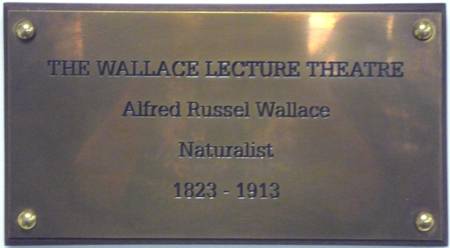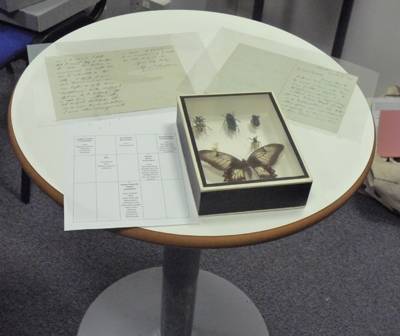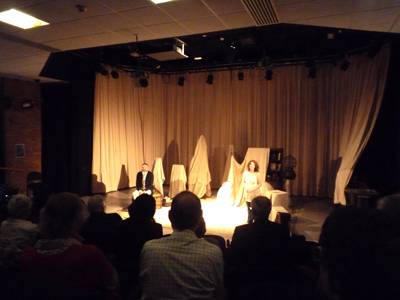Friday 7 June saw Wallace enthusiasts descend on the University of Bournemouth for a one day conference on Wallace, fittingly held in the Alfred Russel Wallace Lecture Theatre, organised by the Linnean Society and The Society for the History of Natural History.
Entitled "Unremitting passion for the beauty and mystery of the natural world" the day included 6 talks about different aspects of Wallace’s life and work, a theatre performance by Theatr na n’Og called "You should ask Wallace" and an evening reception at Bournemouth Society for Natural Sciences.
The morning was kicked off by Andrew Sortwell and David Orr Kerr who gave a fascinating talk of following, quite literally, in Wallace’s footsteps with two expeditions to the Amazon, one in 1978 and one in 2007. They shared with us amazing photos of some of locations Wallace would have visited during his 1848-52 expedition there and shared with us photos of native boats, much like Wallace would have travelled in. In 1978 the Wallace Expedition to Amazonia spent three months in remote regions of the Amazon studying the flora and fauna and in 2007, the second expedition involved travelling to the Rio Negro and spending some time in an Indian Reserve. They also visited São Joaquim, now deserted but the village where Wallace nearly lost his life to illness during his expedition. Their talk was fascinating and it was great to see photos of specimens Wallace would have collected and also to see some of David’s beautiful watercolours from the trip.
Janet Ashdown, conservator at the Linnean Society was the next speaker and spoke about the project she worked on to conserve Wallace’s 10 notebooks from the Amazon and Malay Archipelago. The Society acquired the notebooks in 1936 after Wallace’s son William offered them via Edward Bagnall Poulton. In 2011 funding was awarded by the Mellon Foundation to digitise the notebooks, but they were in a poor state of repair and needed to be conserved first. Each notebook was in a varying state of disrepair with his Amazon notebook needing the least intervention. There were four notebooks that were really degraded with Janet commenting they had been strangely constructed with straw-board covers. There were also old repairs that had been undertaken and unfortunately old covers had to be permanently removed because of degradation, however they have been kept and the new covers have been modelled closely on the originals. This was a really insightful talk and I enjoyed learning about the method and the time it took to restore these notebooks to their former glory. These notebooks have also just been digitised and are free to view on the Linnean Society’s website.
The final talk before lunch was given by Professor Jim Costa on insights and observations into Wallace’s Species notebooks. Professor Costa’s research into these notebooks will be published in October this year in his new book entitled On the Organic Law of Change. The species notebook (held by the Linnean Society, mc. 180) covers the period 1855-1859 whilst he was in the Malay Archipelago, a period of "remarkable creativity" for Wallace as Jim put it which saw the publication of the 1855 Sarawak Law and the 1858 Ternate Essay that saw him catapulted to fame alongside Charles Darwin. Jim also highlights Wallace’s critique of Sir Charles Lyell in his notebook, showing Lyell to be an inspiration to Wallace during this time. Jim has studied, transcribed and annotated the notebook for his new book, which is bound to give new and interesting insights into Wallace and his time spent in the Malay Archipelago.
After lunch, I was lucky enough to have been asked to speak about the Wallace Correspondence Project and it was great to be able to share with so many people details about the project and to show people just what an amazing resource Wallace Letters Online is.
Also speaking in the afternoon was Annette Lord, a volunteer at the Oxford University Museum of Natural History who spoke about Oxford Wallace’s collection, which consists of over 300 paper items in the Wallace archive, mostly letters and postcards dating from 1860 to 1913 and tens of thousands of specimens collected by Wallace and numerous type specimens, including Wallace’s famous giant bee, Megachile pluto. It was really interesting to hear Annette talk about Oxford’s collections on Wallace and she recounted many great stories told in the letters, mostly to Edwards Bagnall Poulton and Raphael Meldola, all of which are available to view on Wallace Letters Online.
Some lovely specimens from the Oxford Wallace Collection
The final talk of the day was given by Dr Charles Smith and focused on Wallace and Natural Selection. Charles explored Wallace’s 1858 Ternate paper - the one which he sent to Darwin and was subsequently read with Darwin’s work on 1 July 1858 at the Linnean Society - and asked how much we really knew about Wallace’s own evolution of thought and explored Wallace being influenced by the works of Alexander von Humboldt. A thoroughly interesting talk and a great end to the presentations.
We were then treated to an excellent performance by Theatr na n’Og with a play called "You should ask Wallace". The play tells Wallace’s story, with one actor playing Wallace who recounts his childhood, early surveying career and expeditions to the Amazon and Malay Archipelago. They perform the play in schools around Wales and this year are busy with performances to a wide range of audiences. It was excellent and the actor who played Wallace bore more than a passing resemblance to the young naturalist! It’s a great way to engage a younger audience in Wallace’s extraordinary life and to inspire them also and it was really interesting seeing the play as it helps you to better imagine the challenging feats Wallace undertook.
A Q&A session with Theatr na n'Og after their great performance
To round off the day there was a drinks reception at Bournemouth Society for Natural Sciences, which gave the delegates a chance to chat to one another about the days interesting talks. It was lovely talking to people so enthusiastic about Wallace, in such interesting surroundings, with the Society’s headquarters full of interesting specimens.
The lovely surroundings of the Bournemouth Society for Natural Sciences
Wallace and Darwin both honoured at the Society's headquarters
I’d like to say a big thanks to the Linnean Society for organising such an interesting day; another great success for Wallace100!







